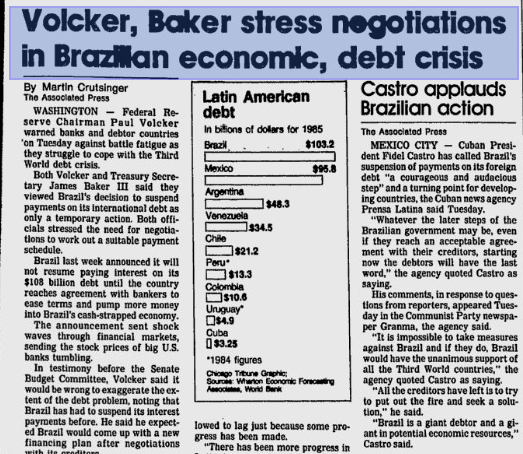Emerging markets like Mexico and Brazil initiated in the 1970s a growth path via rising oil and commodity prices and the increase of debt – based on the at time very strong Keynesian influences. From 1982 on they did not receive enough income from commodities, the dutch disease of the 1970s became apparent. Growth in emerging markets, especially in Latin America collapsed, it let a lost decade.
Volcker and the Brazil Debt Crisis
Volcker saved the United States and made the emerging markets relatively poor, for nearly two decades. Oil was cheap. The Swiss safe-haven, that takes profit of short distances in times of high oil prices and that has trade surplus to emerging markets, was not needed any more.
Contributed by Jerome Roos, of Roarmag.org, reflections on a revolution
Mexico’s collapse of 1982, the extreme response of the US and IMF and the following Latin American debt crisis marked the birth of an elite consensus that continues to haunt Europe today.
As Nick Dearden, Director of the Jubilee Campaign for debt cancellation just wrote for the New Statesman, the week of August 22, marked the “anniversary of an event of great resonance”. For this week it is exactly 30 years ago that Mexico temporarily suspended its debt payments to foreign creditors, thereby marking the beginning of what would eventually escalate into the first international debt crisis of the neoliberal era. Things would never be the same again.
The global ascent of Wall Street
What ensued was not only a tragic collapse of living standards throughout the developing world and a lost decade for Mexicans and millions of poor people in the Global South – most notably in Latin America, Eastern Europe and Africa — but also a historic shift in power relations between debtors and creditors in the emerging global political economy. Indeed, 1982 marked the global ascendance of Wall Street. As the famous geographer David Harvey put it:
What the Mexico case demonstrated was one key difference between liberalism and neo-liberalism: under the former lenders take the losses that arise from bad investment decisions while under the latter the borrowers are forced by state and international powers to take on board the cost of debt repayment no matter what the consequences for the livelihood and well-being of the local population.
In the lead-up to the 1980s debt crisis, Wall Street banks had lent lavishly to developing country governments. The oil crisis of the 1970s had led to huge capital surpluses in oil-producing countries, which subsequently reinvested those surpluses through US banks. As a wall of liquidity flooded international capital markets, interest rates fell precipitously. Countries like Mexico went on a borrowing spree. And the banks were only all too happy about the arrangement. After all, as Citicorp CEO Walter Wriston put it, “countries don’t go bust.”
All the while, the US government stood by passively as American banks lent billions of dollars, mostly to Latin American governments. When the US was finally faced with an economic crisis of its own, induced partly by the oil crisis of the 1970s but more importantly by the long-term decline in the rate of profit of its own industrial sector, the Chairman of the Fed, Paul Volcker, decided to dramatically raise interest rates to put an end to stagflation and break the economic consensus (the so-called Keynesian compound of embedded liberalism) that had reigned supreme since WWII.
This, in turn, immediately pushed developing countries into fiscal trouble. Because most of the loans these countries had taken on were denominated in dollars, the hike in US interest rates — which became known as the Volcker Shock — immediately raised interest payments for these governments. Mexico was only the first country that found itself incapable of servicing its debt. In the years to come, many dozens more would follow in its wake.
But the US government, desperate to avoid losses for Wall Street, rapidly mobilized the IMF and World Bank to disburse large bailouts for developing country governments around the world. Starting with the $4 billion bailout of Mexico, the IMF and World Bank rapidly saw their international leverage increase. Unsurprisingly, they were immediately accused of fending for the large banks — not for the poor countries they purported to “bail out”.
Sanguine austerity on developing countries
After all, one of the first things the “troika” of the US Treasury, Fed and IMF made sure to do, was to impose dramatic conditions on its loans to developing countries. Not only were Mexico, Brazil, Argentina, Poland, Egypt and dozens of other countries forced to immediately impose draconian austerity measures; they were also expected to don what Thomas Friedman would later call the “Golden Straitjacket” of neoliberal free-market ideology.
The year 1982 thus marked the emergence of what became known as the “Washington Consensus“. This term, coined by US economist John Williamson, referred to a list of policy prescriptions developed by US officials in collaboration with technocrats at the IMF and World Bank, and quickly gained notoriety throughout the developing world. As Harvard economist Dani Rodrik wrote, “stabilization, liberalization and privatization became the mantra of a generation of technocrats who cut their teeth in the developing world, and of the political leaders they counselled.”
The result of this new neoliberal elite consensus — that free capital flows, a deregulated financial sector and powerful private banks were good for the economy — were catastrophic for Mexico. As Dearden writes, “the economy collapsed and stagnated, many industries shut down, with the loss of at least 800,000 workers altogether. By 1989, the Mexican economy was still 11% smaller than in 1981. Meanwhile, the debt doubled from 30% of GDP in 1982 to 60% by 1987.” As World Bank Chief Economist Joseph Stiglitz would later put it during the Asian Crisis of 1997-’98, the “medicine” actually killed the patient.
In one of her seminal books, Mad Money, the British political economist Susan Strange was no less sanguine about who was to blame for the Mexican crisis and who eventually paid for it. “On balance,” she wrote, “the banks had been helped out with public money,” while “the governments had had to give in to the market.” Indeed, “the United States had arranged a rescue package, [but] it was the Mexican economy and the Mexican people that suffered most.”
The Latin American debt crisis
“The same story,” Dearden continues, “was repeated across Latin America. In 1990 Latin American economies were on average 8% smaller than they had been in 1980, and the number of people living in poverty increased from 144 million to 211 million. Former Colombian Finance Minister Jose Antonio Ocampo calls the bail-out responses ‘an excellent way to deal with the US banking crisis, and an awful way to deal with the Latin American debt crisis’.”
All in all, it took the international community (read: the US government) an astonishing seven years to realize that some form of debt restructuring was necessary. Finally, in 1989, a blueprint plan was set up to reduce Mexico’s debt — one that would later be repeated across the developing world. Largely initiated by Wall Street bankers themselves, but named in true Orwellian fashion after the US Treasury Secretary at the time, the so-called Brady Bonds were supposed to help alleviate the intolerable debt load of developing countries.
In reality, they were just a way for Wall Street banks to bring order to their books while reaping windfall profits from a situation that should, for both practical and moral reasons, have seen them go bankrupt. As economic historian Harold James pointed out in an IMF-commissioned study, the Brady Bonds deal only reduced Mexico’s debt by a negligible 2.7% of GDP. While this restored confidence to financial markets, it barely helped Mexico.
In 1990, the New York Times wrote that “the jury is now in on the 1989 debt restructuring agreement between Mexico and the international financial community. Unfortunately, the deal is a bad one for Mexico.” Similarly, economist Michael Dooley wrote that “the banks were the clear winners of the game, because the expected bailout was forthcoming … while the debtor countries embarked on reform programs in the narrow interest of the banks.”
As Lee Buchheit, a world-renowned lawyer known as the “philosopher-king of sovereign debt”, explained it, “while the terms of the packages should be beneficial to the debtor country, the US government will not support a package that would compel US banks to recognize losses which could undermine the financial integrity of the banking system.” In other words, “too big to fail” was already a problem back in the 1980s, and the Mexicans know all about it.
Asia crisis repeated the pattern
Ironically, what happened in Latin America, Africa and Eastern Europe during the 1980s would later be repeated in near-identical fashion in South-East Asia. Even though it wasn’t Asian governments that had indebted themselves, but Asian firms, the US Treasury and IMF responded in similarly aggressive fashion, prompting free-market economist Jagdish Bhagwati to refer to a Wall Street-Treasury complex dominating the US foreign policy agenda (political economist Robert Wade, my Professor at the LSE, would later add the IMF to that list).
European debt crisis: history will repeat itself again
Now the observing reader will already have noticed where this story is inevitably headed… As Larry Elliot, economics editor of the Guardian, just summarized it, “for Mexico, read Greece.” After all, there are not only similarities in the deep cause of both crises (systematically over-leveraged banks of the core recycling capital surpluses through peripheral countries), but, as Elliot points out, “the policy response to the crisis has also been identical”:
In 1982, Latin American governments were lent money by the International Monetary Fund so that they could pay back the banks that were threatened with going bust as a result of their stupidity. As in Greece today, the money was given with one hand and taken away again with the other.
In the end, it seems that Hegel was right to point out that history repeats itself. But it took Marx to point out that it does so first as tragedy, and then as farce. What is happening in Europe today is an almost identical reflection of what happened in Mexico in the 1980s — only the banks are even more powerful; Greece, as a member of the eurozone, is even more systematically stuck in its Golden Straitjacket; and the eventual collapse will be even more dramatic.
In Mexico, the 1980s tragically became known as la decada perdida – the lost decade. Millions of lives were ruined as the Mexican economy was decimated. If Mexico and Latin America have one lesson to teach to Greece and Europe, it would therefore be this: if you don’t break the bank, the bank will break you.
Either the people of Europe topple their own states and the Troika, or the states and the Troika will topple the people. What will it be?
See more for























